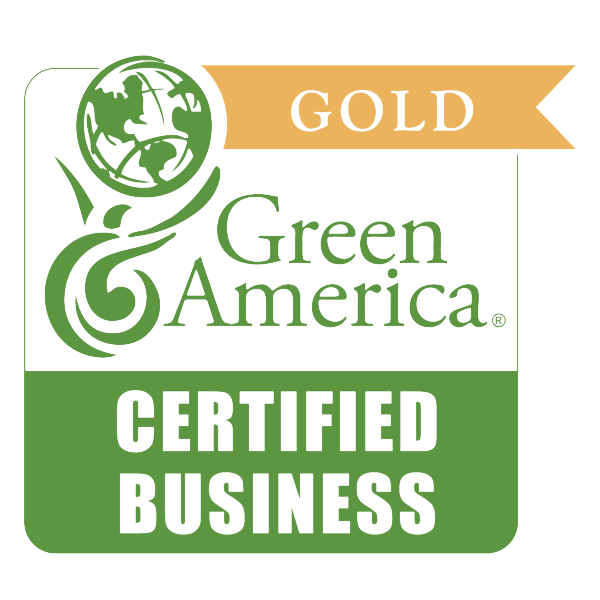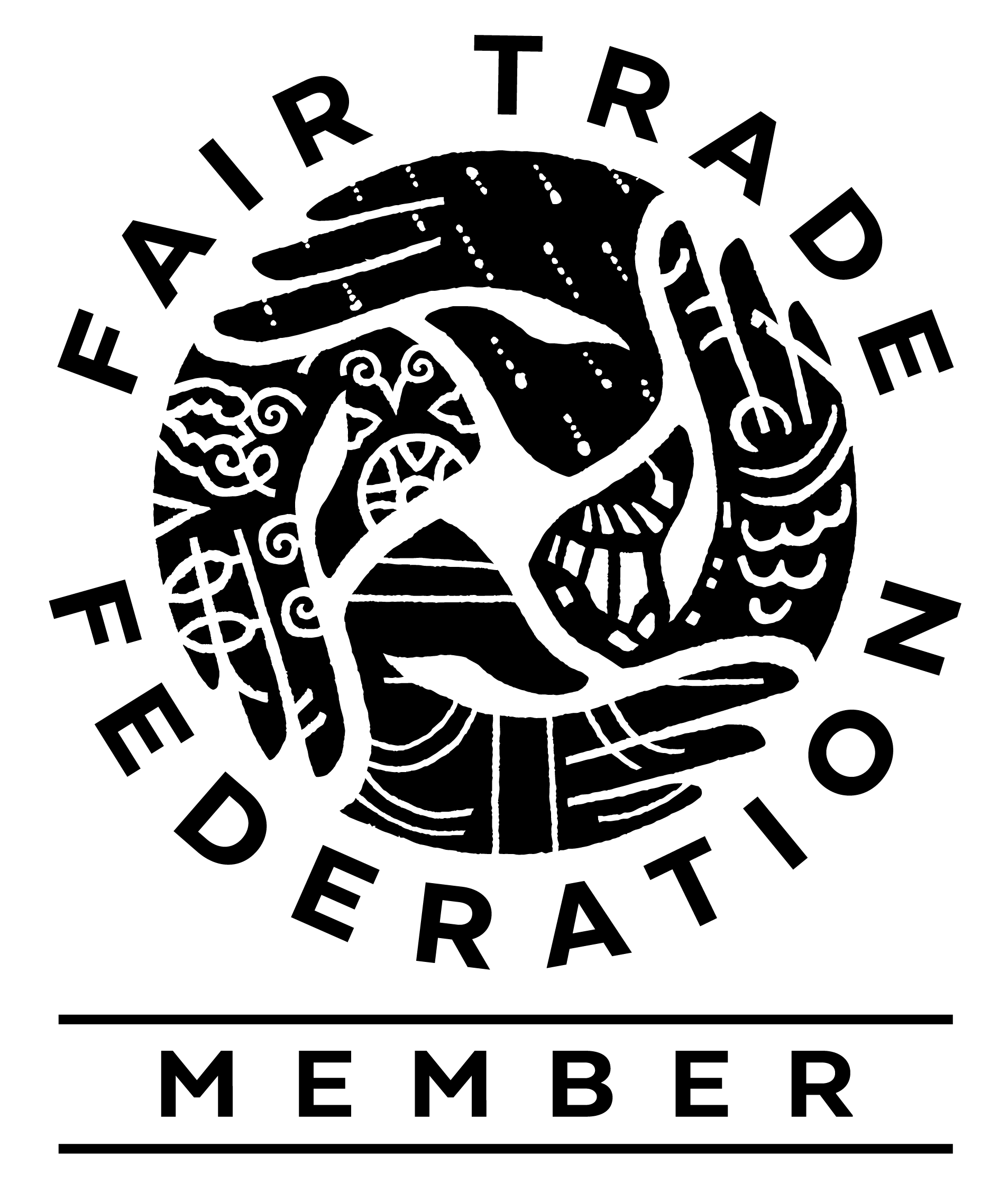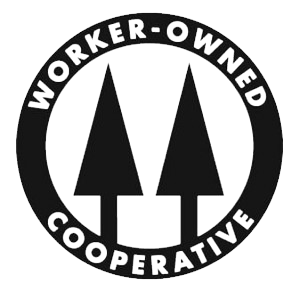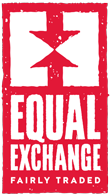Check out our wholesale case product guide to see case quantities and pricing. If you’re wondering how much your group could earn by marking up the products, we’ve given you some examples of how you might price the products below. Remember, you pay Equal Exchange the wholesale case price so you should mark up the products for sale to your customers.
Some groups want to keep prices as low as possible for their shoppers. They divide the cost of the wholesale case by the number of items in it, and then round up to the nearest dollar. Others mark the products up a little bit more, closer to what you might see in a retail store. Either way, small-scale farmers benefit!
We’ve listed our most popular and giftiest items below*. You can use this handy shopping guide to purchase these best-selling products in one collection.
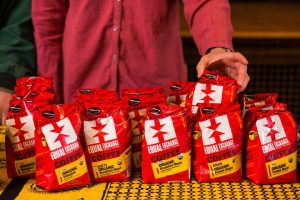
You may choose to mark the products up from wholesale case price by rounding up to the nearest dollar, or you can choose to mark them up to whatever price point you think they’ll sell at and help you achieve your fundraising goals. If your goals are to raise money through the sale, examples of reasonable prices are: $10 for 12oz bags of coffee, $12 for 1lb bags of coffee, $5 for chocolate bars, $6 for tea, $15 for olive oil and $7 for cocoa. By marking up prices you could even use the profits to pay for your group to serve organic, fair trade coffee, if you aren’t already serving Equal Exchange coffee regularly.
Want more variety? Consider ordering baking cocoa, nuts, and chocolate chips.
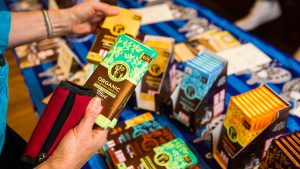
Possible add-ons include baking cocoa, nuts and chocolate chips. You might also offer empty baskets or bows for a small fee. People can make up their own gift baskets on the spot.
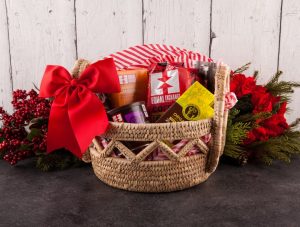
Again, you can mark up the products from wholesale case price by rounding up to the nearest dollar to give people a great deal, but if you sold everything on that list at slightly larger mark up ($10 for 12oz bags of coffee, $12 for 1lb bags of coffee, $5 for chocolate bars, $6 for tea, $15 for olive oil and $7 for cocoa) your group would profit over $500!
For more variety and a larger impact on small-scale producers, consider adding nuts, chocolate chips or beautiful fair trade craft items from Ten Thousand Villages or SERRV.
Ready to order? Purchase on our webstore or call your order into our team at 774-776-7366. Here’s a handy price list template you might use. Find more display and promotional resources here.
We recommend leaving at least 10 business days between the time you order and when you can expect delivery of your Equal Exchange goodies!
*Please note: It’s impossible to know exactly how much people will buy from your sale, therefore these quantities are only suggestions to help you plan. Because they are consumable products, we can not offer them on consignment.
We strongly encourage you to to purchase only what you are confident you can sell through during your event.
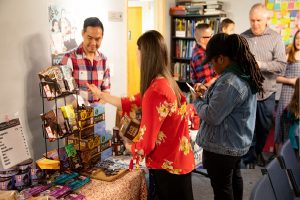
Customizable bulletin inserts and e-bulletins/newsletters to promote your sale
See our full list of educational and promotional items here >>
Festively dress up your table and make gift baskets or ready-to-give gifts>>
Fair trade fundraising organizers are seeking online options to save time, stay organized and raise more money. We’re pleased to offer some of Equal Exchange’s best-selling products on the online platform created by FarmRaiser!
Mark Abbott, Co-Founder and CEO of FarmRaiser, created the platform after his children brought home school fundraisers selling junk-food products. Mark longed for an easy fundraiser offering healthier options, especially for kids, that would be successful. His answer is FarmRaiser, a tech company with a platform that connects communities with farmers, educates about food sourcing, and offers online organizational tools to make fundraising easier.
Now, you can raise money with Equal Exchange’s fairly traded, organic products on the FarmRaiser platform!

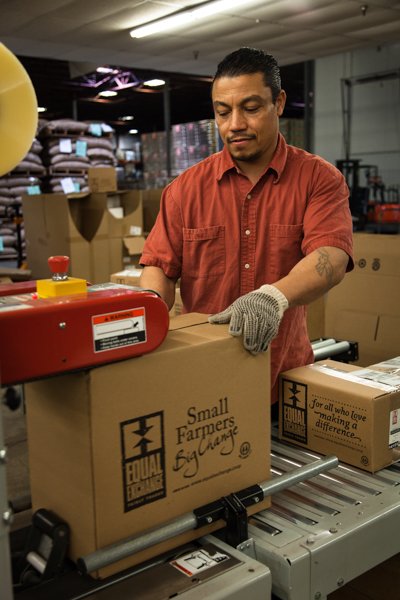 Full cases of product.
Full cases of product.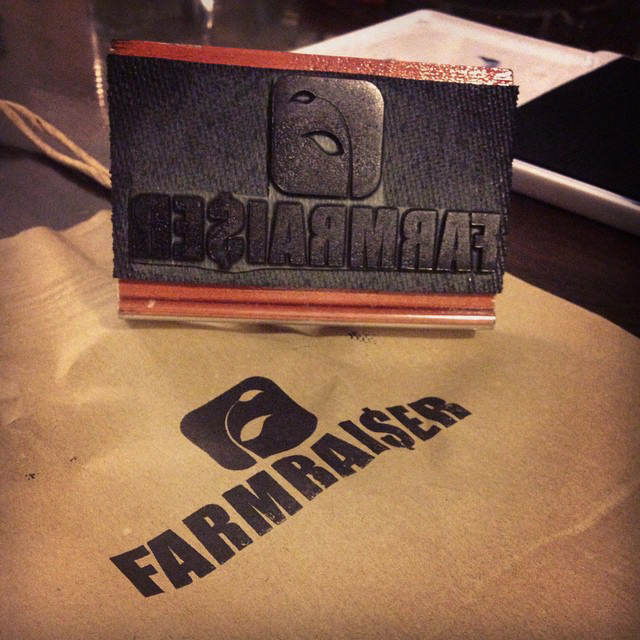
FarmRaiser can help you plan an Equal Exchange fundraiser on their platform. To get started, just fill out this form. If you have questions or want to learn more, contact them at info@farmraiser.com or 571.279.8873.
Equal Exchange’s Customer Service team is always available to answer questions about our products, our farmer partners and your order’s shipping details. Get in touch with us at communityorders@equalexchange.coop and 774.776.7366.
Thank you for supporting authentic fair trade and fundraising with Equal Exchange.
Maftoul, or Palestinian couscous, makes a great vegan or vegetarian filling as it cooks quickly, absorbs additional dressings or sauces, and tastes great with any addition of herbs, vegetables, fruits nuts, or legumes. While I use the traditional Palestinian hand rolled maftoul using wheat, you can substitute any grain for this dish, like bulgur wheat or even quinoa for a gluten free option. You can also use spinach instead of swiss chard, or golden raisins instead of cranberries.
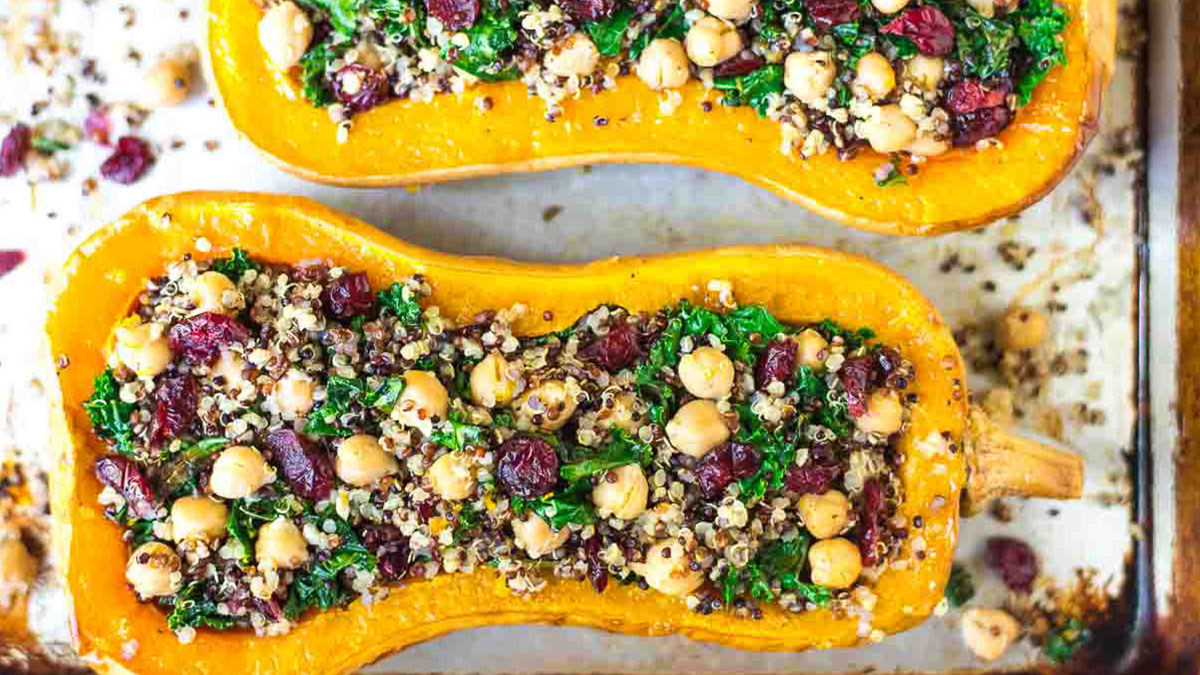
Recipe & photo courtesy of Blanche, feastinthemiddleeast.com.
You can plan a short presentation using a combination of talking points and videos. If a presentation sounds too formal, just have a conversation with someone who is a decision-maker in your group or send them some of the info below in an email while explaining why fair trade is important to you.
And having some Equal Exchange coffee or chocolate on hand for folks to taste might help them experience how delicious they are while they learn about the mission behind them.
Brush up on your fair trade knowledge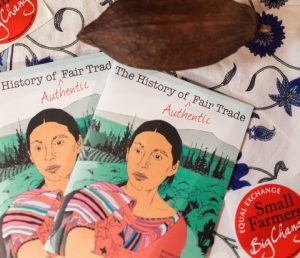
Share the Equal Exchange basics
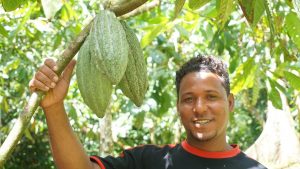 Show the impact on farmers
Show the impact on farmers
Learn from other fair trade program organizers
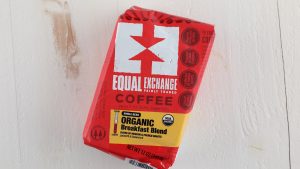 Why switch your coffee?
Why switch your coffee?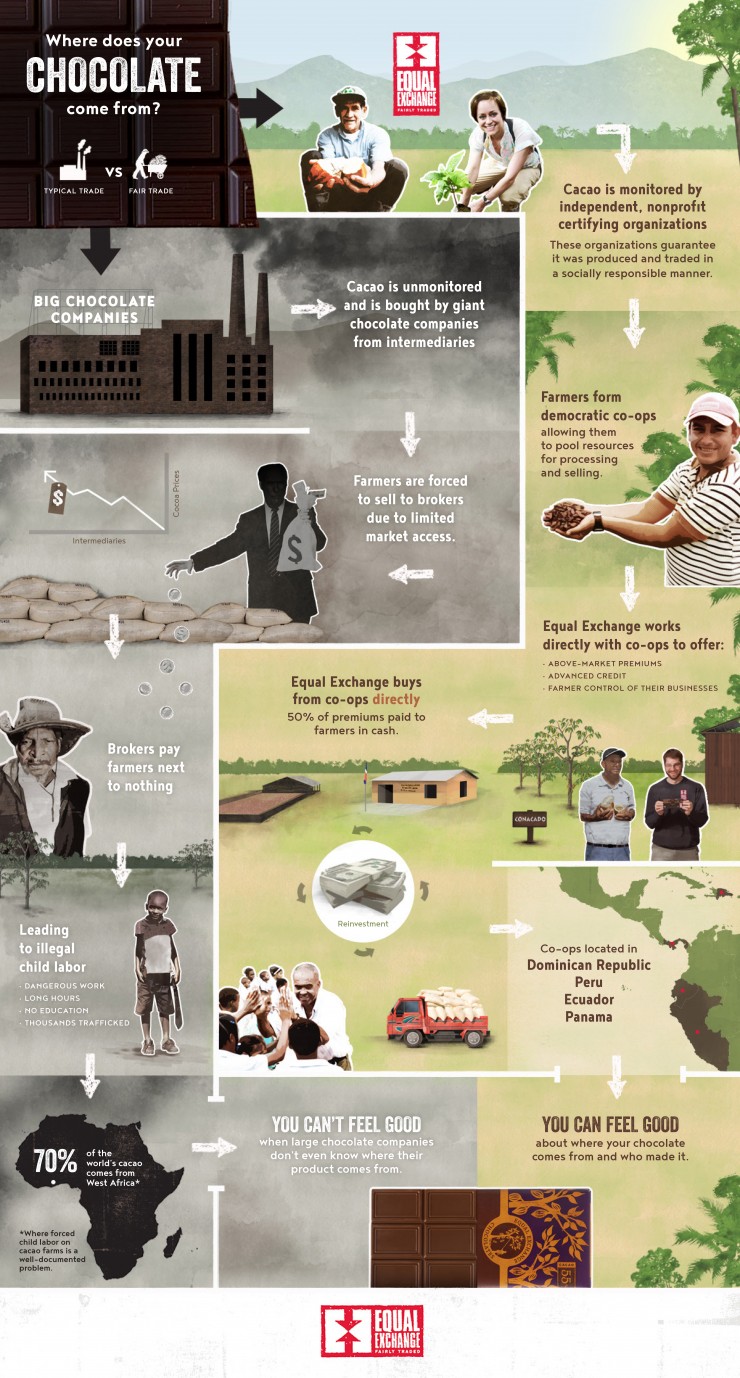
Big name chocolate companies like Nestle, Mars and Hershey’s were recently called out in a Washington Post story for unethical sourcing and child slave labor in the chocolate industry. Be sure you’re not supporting injustices you don’t believe in.
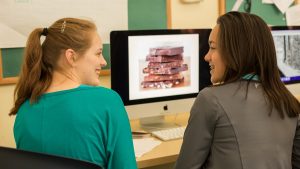
Want more?
Explore all of our educational materials>>
Browse educational materials tailored towards youth>>
How to order:
Order by phone or call us with your questions at 774-776-7366
|
|
|
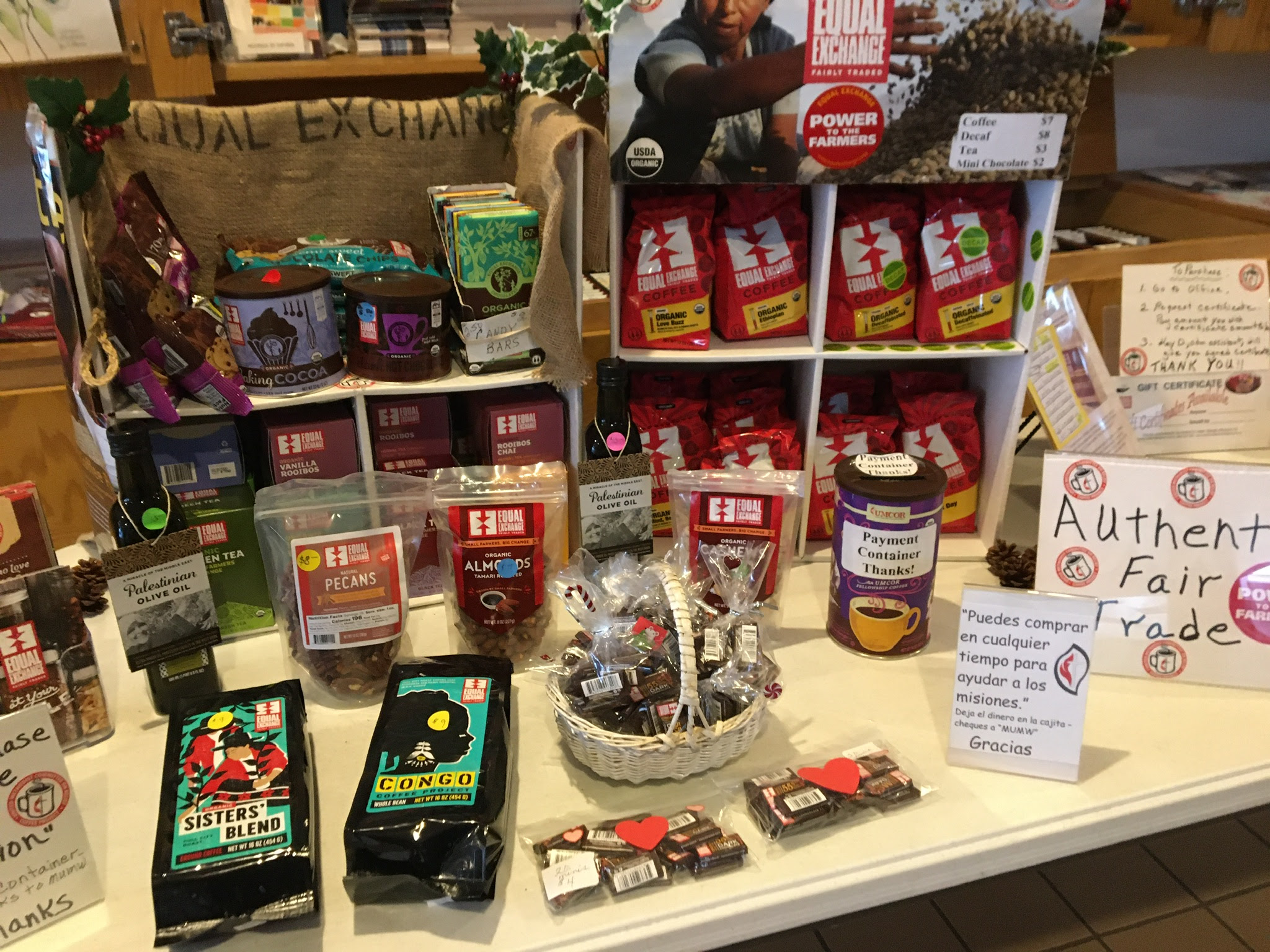 The fair trade sale table at Monona United Methodist Church
The fair trade sale table at Monona United Methodist ChurchIn past years at Monona UMC there was a small table with Equal Exchange products in fellowship hall. When the pandemic started the team set up a table that was much more visible in the church narthex, or foyer with instructions for use. The church was open every day from 9am to 2pm so people could buy EE products when ever they needed them. Different groups used the building including mail and package delivery people who also bought products. Everyone left checks or cash in the box on the table. Each week the money was collected, there was never a problem with any missing money.
We honor Kay Mackie, an Equal Exchange Coordinator Extraordinaire. When people ask Kay why she has been so committed to the EE ministry she will say that she is a social justice advocate an environmental advocate and a political advocate. She also describes herself as a person of faith. She saw her role of helping small farmers as a way to serve God and God’s people, and planet.
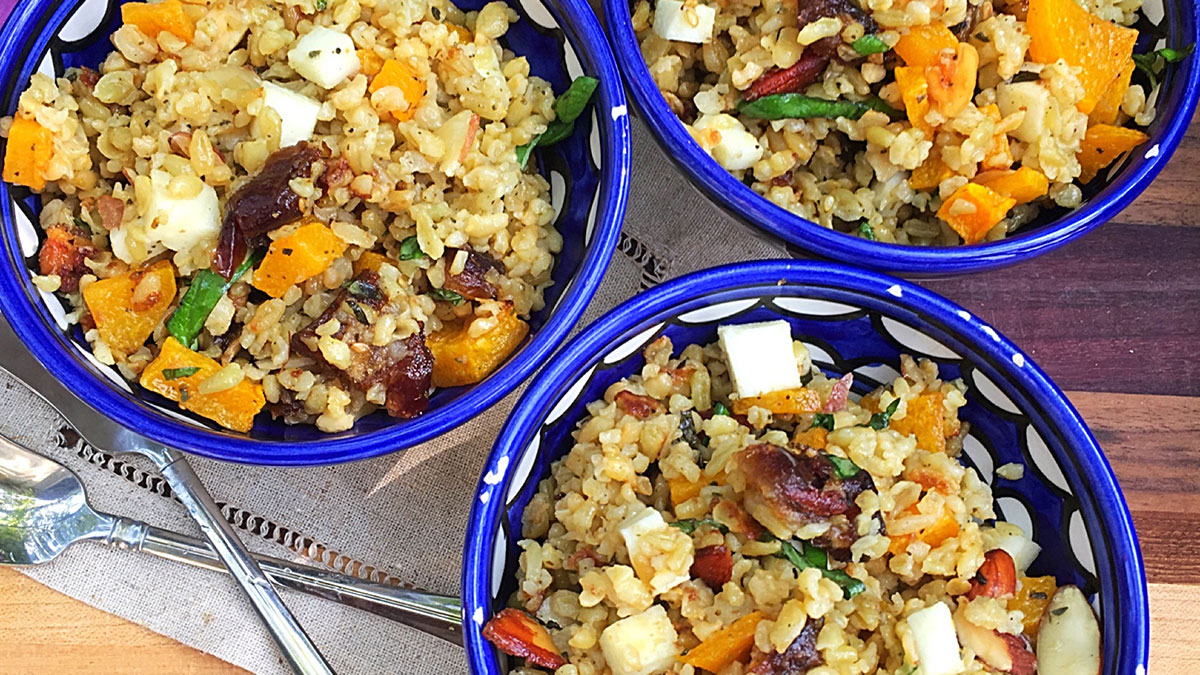
Recipe & photo courtesy of Blanche, feastinthemiddleeast.com.
The modern grocery basket is a true symbol of human innovation. Its contents span continents, offering a taste of all things weird and wonderful, at a convenient arm’s reach for the avid shopper. For many, it symbolizes feats of industry and an ostensible abundance of choice. Yet for the conscientious consumer, filling this grocery basket can be an agonizing task – as we sift through terms like natural, organic, and sustainable and try to decide which product really means it, we each develop our own rules for being “good” shoppers. We place our faith in labels like fair trade and USDA organic, and strive to buy food that is local, whether that takes the form of commitment to food grown in one’s state or within a radius of 100 miles.
Growing up on a family farm, I was lucky enough to have local food available to me every summer. Readers may be picturing a Kingsolverian Eden, or perhaps a blog photo of an influencer sitting serenely amidst sunflowers. The reality is, of course, far less glamorous: days could be spent getting intimately acquainted with corn borer worms, searching amidst dozens of boxes for one rotten tomato that you can smell but can’t find, or explaining to the inquiring customer that everything really is grown right here, pointing outside to the cornstalks and pantomiming the passage of time with the explanation of when peaches will be ready. Life at food mile 0 was not perfect, but it was the embodiment of local.
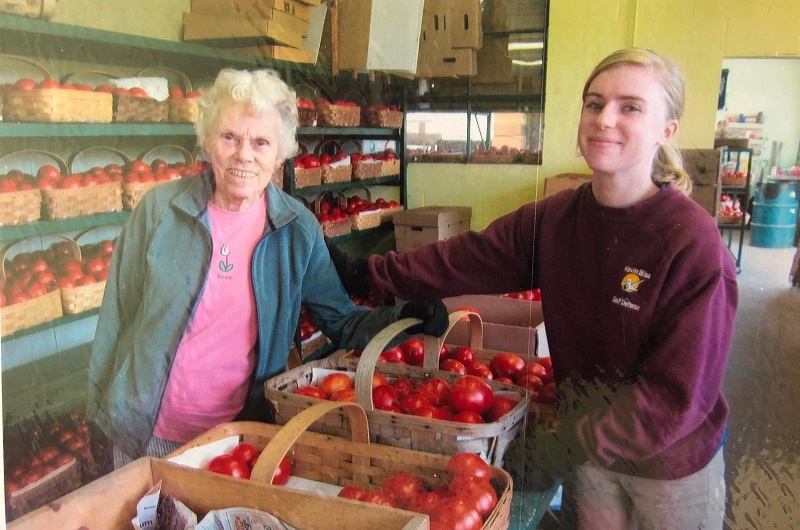
I now work at Equal Exchange, importing produce from over 2,000 miles away, a distance that might shock the steadfast local eater. I have had to rethink the meaning and importance of what makes food “good,” and confront the myths that have surrounded the locavore movement as it has become more popular. There are few laws that regulate “local”: the 2008 Farm Bill sets the limit to local at 400 miles from a product’s destination, while the Food Safety Modernization act sets a stricter limit of 275 miles. The original locavore movement is still stricter; its founders originally set local to 100 miles. With no official label, non-local products may still tempt shoppers with pastoral scenery and artistic hints that their products are from nearby.
Bananas are not local. They do not come from within 275 miles of my family’s farm. In fact, they come from about ten times that distance. However, this does not mean that they do not align with locavore values. To navigate the mysteries of the modern food system, we may better promote the vision and values of the locavore movement by confronting the theories that have upheld it.
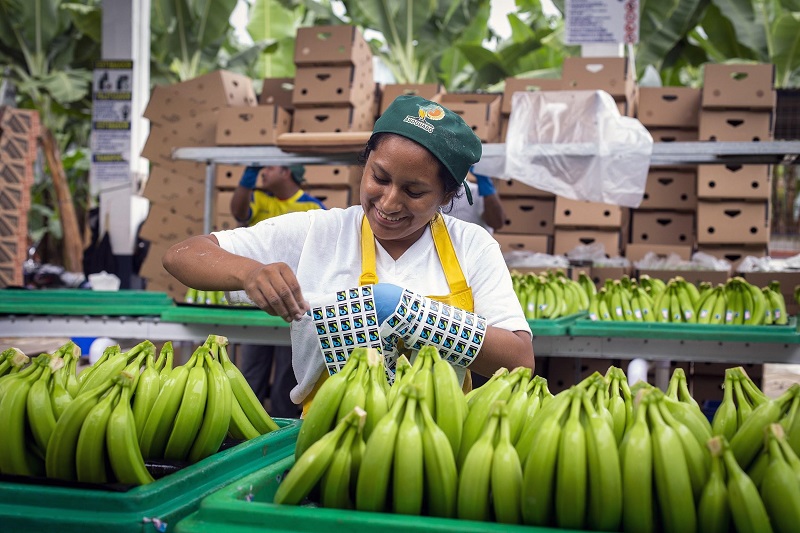
Eating locally, ideally, keeps money flowing through a community, in turn ensuring that those in the community continue to benefit from it. However, not all companies that are geographically close to a shopper are small farms, nor are they guaranteed to continue to cycle profit through a community. Some grocery stores or food companies may be owned by a holding company, and obligated to remit money back to their parent company. Others may have reached such a massive scale that they are focused on national and international growth, sacrificing sustainable practices along the way.
Shopping to meet this tenet of the locavore ethos is never simple, but taking a follow-the-money approach enables shoppers to support products that share their values. And this is where bananas come in. Buying EE bananas from a local food co-op not only keeps money cycling through your community, but also ensures that communities of farmers in Ecuador and Peru are receiving a fair price for their products, which then keeps money flowing through their communities, as well. In a way, eating fair trade bananas gives you a local eater two-for-one, and you support both your community and the cooperative community of farmers that grew the fruit. It may not have been grown physically close to your co-op, but it creates an interconnected network of solidarity between communities.

According to Mike Berners-Lee, a professor at the Institute for Social Futures at Lancaster University, bananas are truly commendable for their small carbon footprint, weighing in at 80 grams CO2e (160g/lb) per fruit when you factor in its travel time and the agricultural processes behind it. This number may be even lower in 2020, as many maritime organizations have committed to lowering fuel emissions, committing to fuels and vessels that are safer for the environment.
Compare this 80 grams per banana with 3.3 kilograms CO2e for a pound of strawberries (imported by plane or greenhouse-grown out of season will have the same sized footprint). Local meat would be still higher, at about 19 kilograms CO2e per pound.
Luckily for banana lovers, many fruits and vegetables have particularly low footprints because they are eaten raw, dodging the steep toll that a quick fricassee may have on the net emissions of the fruit. Sustainability pundits estimate that for cooked products, transport weighs in at 6-7% of total emissions, while cooking is closer to 11%, and production is an astonishing 81% (W. Wakeland et al 2012: 225). It is in production that bananas, particularly sustainably-grown bananas, gain their edge. They are already in a natural greenhouse, taking advantage of the heat and humidity of their local environment, unlike a local year-round greenhouse which creates emissions by trying to simulate bananas’ natural environment.
Being a sustainable locavore requires, like many things, that you ask questions of your food. The following questions may not always lead you to purchase a local product, but they will enable you to think critically about the items in your grocery basket and choose items that are socially and environmentally valuable.
Berners-Lee, M. 2011. How Bad Are Bananas?: The Carbon Footprint of Everything. Vancouver: Greystone Books.
National Agricultural Library. Mailboxes, Mom and Pop Stands, and Markets: Local Foods Then and Now. US Department of Agriculture. Web. https://www.nal.usda.gov/exhibits/ipd/localfoods/exhibits/show/food-locality/local-distance
Pollan, M. 2001. Naturally. The New York Times. https://michaelpollan.com/articles-archive/naturally/
Wakeland, W., S. Chollette, and K. Venkat. 2012. Food Transportation Issues and Reducing the Carbon Footprint. In J.I. Boye and Y. Arcand (eds.), Green Technologies in Food Production and Processing, 211 Food Engineering Series. New York: Springer Science + Business Media, LLC.
Interview by Jennifer Pruess, Equal Exchange
Welcome to the third installment of our mini-blog series: Equal Exchange Goes Out West to Stay. We now reach a branch in the story where the early days of Equal Exchange in Portland meets with our move to bring coffee roasting in-house. We will begin our exploration into this leg by sharing a conversation I had with Beth Ann, our Coffee Quality Control Manager, back in late November, 2018.
Hi, Beth Ann! I’ve been looking forward to chatting with you since your name has come up in previous interviews with Tom & Wells while discussing the early days of Equal Exchange in Portland.
They both mentioned events leading up to bringing coffee roasting in-house. I thought it was time to bring these stories to light in celebration of our accomplishments while simultaneously peering into our future to see what the next chapter may bring.
My first question is how did you get started working with Equal Exchange? How did you hear about Equal Exchange and what was your first role with the company?
I went to Wheaton College in Massachusetts. They started serving Equal Exchange on our campus. This is in 1993 and I was an Anthropology major. They had an essay contest that was basically saying if you win the essay contest you have an opportunity to go and meet small-farmers in El Salvador.
Equal Exchange had the essay contest?
They had it with Wheaton College together, it was basically sponsored by both of them, but the idea was that the trip was sponsored by Equal Exchange. They wanted to take staff and students down to visit farmer coops. I won the essay contest with another woman. So, I went with one of the founders, Jonathan Rosenthal (one of the original founders of Equal Exchange) to El Salvador in 1994. We went for a ten day trip and it blew my mind completely.
It was my first time in a third-world country and it was my first time to Central America. So, I came back sort of transformed. A few years later, I went to do my Anthropology thesis and spoke with folks at Equal Exchange about possibly using Equal Exchange as part of my case study. Which was about specialty coffee and the difference between paying a fair price vs paying a commodity price. Then giving sort of aid money or additional money to farmer groups or to different projects after the fact. So, it was a comparison between those two things and I used Equal Exchange and Starbucks which was a monster compared to Equal Exchange at that time. This was 1995 to 1996.
I got an internship with Equal Exchange during the winter of that year and then they had a sales position open up in Massachusetts. I was the lucky recipient which was awesome, but I was an Anthropology major. I wasn’t quite sure if this was a good fit for me. The company was, selling…not sure what that was. I took the job and did sales for the mid-Atlantic for two years while I was based in the Canton office. I shared an office with Tom (Thomas Hanlon-Wilde, Co-Executive Director of La Siembra, a sister co-op of Equal Exchange based in Canada and the makers of Camino Chocolate). I knew Tom and some other folks like Jessie Myszka (Director of Support Operations). Jessie was hired at the same time as me. We are of the same class- as we like to joke!
Then about two years later, my mom passed away unexpectedly. I decided to leave Equal Exchange to deal with the house and life and I moved back to Connecticut. This is where the story gets a little bit hard to explain. I’m not sure if it’s blog worthy, but it’s kind of funny crossover material.
Anyways, I left for a while and then I ended up in Oregon because I met Todd (Todd Caspersen Director of Purchasing & Production at Equal Exchange) in passing. We fell in love, he moved to Oregon, and I followed him like a crazy 25 year-old! I didn’t work for Equal Exchange when I moved to Oregon. I moved to Oregon first because there were no sales positions which people felt bad about!
I went and worked for a green trading house, an importer called OPTCO (Organic Products Trading Company). They don’t exist very much anymore, I think they were bought. It was a husband and wife team that imported organic coffee. They were also very mission based and really lovely people. I worked for them for about 8 months, but I decided that I didn’t really enjoy the green side of trading coffee. I was really brought up into this world of small farmers, fair trade, and worker coops. I wanted to be back with roasted coffee and customers.
Luckily, a sales position with Equal Exchange opened and I was hired back as a sales rep in March of 2000. I became the rep for Seattle which was really cool! The Northwest was just a very different world compared to the East Coast where I grew up. I was really excited to be there (the West). I represented all of the PCC’s (Seattle area co-ops) and I was on the road a lot. I think the west coast led the way for sales in terms of being on the road much more, not being on a phone. I really believed that we were the trail blazers and I was going to say no pun intended but then the Trail Blazers are from Oregon!
We didn’t have a lot of resources, but there were good opportunities. Sales was much different then. It wasn’t as regimented as it is now. We were sales, we were customer service, and we were demo people. I even helped to do DSD (direct store delivery) at one point. We didn’t have a DSD person, we did DSD. We were trying to figure out how to do that and how to be local.
So, there was the PCC stores and the Nakata Groups. Tom got the Nakata Group, but I helped to usher them in just as I was coming on. Todd got New Seasons with my help as well as Markets of Choice. Those were a few of our big accounts at the time.
One of the smaller accounts at the time, I didn’t really know how to deal with them because they were food service, was Bulldog News in Seattle. They’ve been with us forever and a day! That was one of the accounts that I’d go up and work with them, and do a lot of demos. I was also doing concerts at the zoo, giving out cups of coffee and hauling around machines. It was a fun time but it was a lot different and a lot of work. We were everything, we did everything.
That relays into my next question concerning what a typical day was like back then. Can you remember what the goals were at the time when you were blazing trails?
We had sales goals. Our goals were to grow sales and maintain accounts but really grow by trying to get into more mainstream supermarkets. We’d call them the elephants. Go after the smaller accounts but try to get some of the larger accounts and try to interest people that were more mainstream because the northwest had a different culture around organic. There was (also) a big movement around shade grown. In some ways it was easier to sell organic at the time. To talk about small farmers was a little bit different. I think that is radically different today.
Our office was a one room office in Gresham. I would take the train when I wasn’t going to Seattle or on the road and then you’d be calling people, servicing customers, dealing with maintenance issues with machines if something broke down. We were it! We got to know everything.
To summarize: the west was comprised of a sales team trying to land accounts and grow fair trade?
Yep, exactly. Trying to grow our brand and have people familiar with it.
One of my questions involves remembering some of the challenges. Presently, our challenges revolve around how we tell our story, talk about farmer-partners, current issues with fair trade, and what it means to be local.
Were you facing any issues being considered a national brand or what sort of challenges were typical at that time?
Oh yeah, I think the challenges are very similar today as they were back then. We were three people on the ground and our coffee company was 3,000 miles away.
We were the local presence, we were the humans on the ground. I think that helped tremendously to begin to build those relationships. I credit Tom a lot with relationship building because he was the first one there. Having that consistency is important. That’s one of the reasons we started doing DSD because we could control the product, go into the stores, and be like: “Here we are! We’re bringing the coffee directly from our hands to yours.”
I think at the end of the day, not being a roaster was a larger challenge for Equal Exchange, period. We didn’t manage marketing at the time and there was no marketing team on the west coast. However, there were a lot of things that we would do on our own just very much like what we do today. Each account needs certain needs and we wanted to take care of their individual needs.
There were less coffee companies then there are today. I mean (now) Portland alone has at least fifty roasters just in Portland or the greater Portland area.It seemed really challenging at the time, but the challenges were less back then around locally roasted (coffee).
One of the quotes from interviewing Tom that has stuck with me is this: “When we show up and are present in the stores, we are local.”
We’ve built relationships in Portland over the years. We’ve built partnerships by delivering products and being present on a weekly, often twice a week basis. I feel like that is a relevant part of what helps to define what local is and I like how you describe it as: “From our hands to yours.”
One of the things that I use to try to say is that coffee is not really local. Coffee is roasted. The vast majority of the work that happens in coffee is not in the hands of the roaster and it’s not in the hands of us. I always tell producers: “You do all of this work. My job is to go out there, maintain how delicious it is through our roasting, and sell it.”
We are selling it. Roasting is an important part of that and it is a craft. However, it’s only one step. That was part of my argument when I worked out West. We take such care when we are roasting our coffee, but at the end of the day, most of the work is happening at origin.
Amen! Unfortunately, I think it’s something that gets lost in the fold. I do hope that sourcing of social and environmentally sound products becomes more of a consideration for global products such as coffee and cacao.
Reflecting on your time out west, do you have any highlights that come to mind?
I think it was a really free time. There weren’t any written rules to what we were trying to do. It was really liberating to be out on the road and to be with customers. Specialty coffee was on the rise and we were in a growth period too. It was just so exciting to be able to go out there and tell our story.
Working with Tom and with Todd was fantastic. Having a small team is really exciting and fun. It can sometimes be really hard too. I can remember driving to Seattle with Tom, we would take road trips sometimes. We would spend 6 hours in a car, 3 hours to Seattle and 3 hours back to Portland. During that time you can learn a lot about people and having that connection with your colleagues really helps to build relationships.
I can remember that I was really interested in learning Spanish and I was taking Spanish classes at night. During one of our trips to Seattle we were listening to a song by Mana, a Mexican band and Tom was translating all the words so I could understand what they were saying. To this day, when the song comes on, I always laugh and think about Tom because he literally translated the whole thing!
It was a hard time too because we were disconnected and isolated from the rest of the company. During the worker-owner meetings, it was us calling in on a phone and huddling around hoping there wasn’t any banging from the other offices or that you could hear or that someone was actually paying attention to us.Technologically speaking, it was very hard to be connected unless you were on a phone. I can remember having my first cell phone, and being like wow, we can talk wherever I go! It was both exciting, challenging, and a little more wild westish back then.
I think we’ll go ahead and transition now into the coffee roasting segment of our talk. To begin, how did this project get started? You were out west at this point?
You definitely need to speak to Todd about this! He was such a primary driver for this work. Todd was offered a job to work in purchasing and I was offered a position to come back east to be in sales but also working quality control.
The thing that I didn’t tell you about is that during my first two years at Equal Exchange, I was a trained apprentice. I worked with a well-known professional in the coffee industry in the greater Boston area for two years. This work was supported by Equal Exchange, to learn how to roast coffee, sort coffee, and how to cup coffee. I am very thankful for that opportunity. Those kinds of opportunities these days do not come easily, but this gentleman was looking for someone to roast samples.
The deal was that I’d go there one day a week. I roasted samples and then we’d cup which was an amazing experience because we’d cup coffees from all over the world! He taught me the basics of my vocabulary.
When I left after a couple years at Equal Exchange, I was like how can I do more of that? When I moved out west, I did a little bit of that with a green coffee company that I was telling you about and then I ended up back in sales. I wasn’t really able to use the same skill-set that I had already developed around coffee quality. I wasn’t in contact with the coffee at all except for the finished product.
When I moved back east, part of my job was to work in quality control and to work on what that was. That was another exciting time, that transition back. It wasn’t just that we weren’t roasting our own coffee on the west coast, we weren’t roasting our own coffee at all. There was this incredible boom of craft coffee, beer, everything and we needed to be part of that! For me, the northwest is so special, as far as the craft movement of food and consciousness of where it comes from and how it’s prepared..
It seemed really necessary to be more involved in the quality of our supply chain. It was something I was really passionate about. Todd can obviously speak to his side about how that felt for him going back and becoming the director of purchasing and being able to do that work in a different way. There’s this growth, there’s this movement that the coffee world is changing. What are we going to do about it? Todd really helped to bring these ideas to life and to a new level.
We needed to change or we wouldn’t be able to compete in the market, I could see that as a sales person on the West Coast. I see it as a few ways. One is that I liked roasting coffee, I didn’t want someone else to roast our coffee when we knew what to do on some level, not perfectly, but I was willing to try and figure it out. I was trained on small sample roaster, but I knew the basics and could see that we could do it. The other thing, is that as a business, you’re dependent on another company roasting your coffee. Basically, you have a middle person doing that work for you.
After we moved back, this idea sort of came to light because we were kind of bursting at the seams in the Canton warehouse. Where are we moving to next? I was like, well, why don’t we build a roaster? Why would we build a roaster? How do you do that? And so it became the Buy, Build, Roast Proposal. It was a really big deal for us and it took a lot of work. So, that was a proposal that basically said go buy it, figure out where you are going to move to, get a piece of land or an existing building, and build a roaster. Again, a ton of work and many different people were involved in many different aspects of the project.
For some people, that was a really easy sale. It was like, duh, why wouldn’t we do this? It’s like being a chef and not making your own food. But, it is expensive. It’s an investment, and it is a risk. Others were like “Whoa! Why screw up a good thing? We’re growing, everything is fine.”
It was a big process. It wasn’t just Todd saying: “Hey, let’s do this.” It was Todd and Rink working with a lot of other folks on a proposal of what that might look like and how it made more sense to actually move the company along with building a roaster at the same time. That had to go to the board and at the time I was sitting on the Board of Directors. So, I had to wear many hats: my board hat, I had to wear my worker owner hat, and my QC hat (quality control). I was very passionate about it and I’d say it felt like it made financial sense, but at the same time, there were risks involved. I’m like: “Come on, life is too short!”
One of the arguments that Todd made pretty early on was this was an inclusion of production workers in the worker owner model which was something that was also a little bit scary for folks who were wondering how we were going to be able to do that. I’m like: “Well, you figure it out. This is Equal Exchange, this is what we do. We figure it out.”
Luckily we’re open to making mistakes, talking about it, trying other things. Eventually the proposal was passed in 2003 and then the process started. At the time, Denise (Denise Abbott), was working for us as the Director of Finance. She was with a small committee working on places, going around looking at real estate, looking at buildings, and that’s how we ended up here in West Bridgewater.
Part of it was about the worker owners, most of which were located in Canton. We had to figure out a place that would meet everyone’s needs. So, we had to bring this (to the worker owners). We want to do this, the board has approved it, and now the actual location goes to a vote for the worker owners. I would say that that was one of the hardest parts. People wanted to be closer to the office. What are the compromises?
There was a proposal that said we’re not all going to be in the same building, we could never possibly do that! Which I disagreed with, but, hey, life happens. That was 2003, it was a long time ago and we just didn’t have that culture. The culture back then was that we would have lunch together, we would see each other, everyone knew each other and knew their kids or whatever was happening in their lives.
So, it was never a decision for roasting to happen either on the west coast or east coast. You and Todd actually were back in West Bridgewater when this discussion of bringing roasting in-house started to happen.
Yes, it wasn’t about bringing Todd out to the east coast or me to roast. It was all about the need to amp up. We’re growing a lot and we need to amp up these sections of the company. We need to work on quality. In the Fall of 2001, I basically moved into full-time Quality Control. I wanted to dive into quality work, I was trained to do it, I wasn’t sure what to do exactly, but I wanted EE to take a chance on me.
That’s so cool!
Yeah, I knew how to cup, I knew how to sort, I knew how to roast. So, I developed all the standards and all the practices that we started out with.
Incredible. So you were the only one in the organization with that knowledge?
No. Souza (Mark Souza, Procurement Guy) had some cupping knowledge at the time and then that responsibility was passed to me. Todd basically learned how to cup from me and from others over time. By cupping with producers and such, but most of his time cupping has been with me.
It sounds like this was a time of excitement, that everyone was pretty gung-ho about it while feeling a little nervous about taking a big risk like that. This was such a big change for the company!
I think it was a necessary move from a crafted specialty perspective too. I feel like we were doing ok, but I feel like this helped to catapult us to a different level. We were proud. We are making it, we are owning all of it, when it’s delicious, when we make mistakes, when we mess it up. I think that ownership and that really transferring that into quality infiltrated the whole organization over time. Even today, I think.
If you were here 10 years ago, you would see that transformation, but I feel like today it’s just assumed. There are these assumptions of great quality because of who we are and what we do which are important mission statements. It’s a part of our mission, but I think people are really proud of what we do and I hope that’s translated somewhere down the line. We’re really proud of what we do here and our relationships with farmers..
Do you think there’s anything else that’s happened in the history of Equal Exchange that compares to the decision of owning roasting? Anything that’s sort of been a transformation for the company?
Not on the same level and it’s sort of auxiliary to some things, but I really think that the USAID work that we’re doing is pretty frickin’ phenomenal and that we’re engaging in a new USAID grant has had radical impact that really is wildly understated. We don’t talk about it very much, It’s not written about or marketed but the impact has been unbelievable.
In the first round of the grant, we did seven years and I was a part of it for five. It’s not on the same level for me as Buy, Build, Roast it is just different, it’s development work that compliments all that we do everyday. For me, professionally, I have learned so much, it’s been phenomenal.
And I think many of the farmer-partners too. The support, the love, the care, and helping to develop things that are not just a North/South- East/West-, it’s an all inclusive project where we’re directing the funding and things, but like I said, people don’t even know enough about it. That in and of itself is a blog piece.
Yes, I was just about to say that. We do need to talk more about it.
Yes, there’s been tremendous work.
So, we’re getting down to the last few questions here.
Looking at where we’ve come from and where we’re going, what challenges do you think Equal Exchange faces now with where things stand with Fair Trade versus Authentic Fair Trade? How do you think we are we maintaining our values?
I think some of the challenges are, and I’m speaking specifically to coffee, that’s what I do and I think that I can see it from a larger, ten thousand foot- macro level. I feel like there’s just this changing coffee environment. It’s not just about the small companies getting eaten up by the larger companies. It’s a scale question, right? We’re not a giant at EE, but we’re not tiny. So, you’re not the micro-roaster in Portland, but were not Keurig.
I think that’s a really hard place to be because once you get to that place you have to be more mainstream or you gotta figure out what that means and I think we’re seeing those challenges right now in all kinds of places. I would say we have lots of different people all over the country. I think we can be multinodal which is amazing. I think technology has really helped with that. I go back to that example of us huddling around a phone and being like “What did they say? Who’s talking?” You don’t have that now. You and I are talking on a video screen and we’re having
a conversation.
I think we’re stuck in this place where our coffee is not expensive. In my mind, I think we should be charging a lot more, but, my gosh, someone else might tell me I was crazy. We buy really great quality and I think that farmers would argue that we probably should charge more, but I also think that we are in a sales environment where people expect a good price. I’ve always said to farmers: “We pay you a good price and then we want consumers to be able to pay a good price because we want it accessible.”
We’re not trying to be super snobby about the coffee, but at the same time, I do think that it seems kind of cheap to me! I think about that. I love different kinds of craft beer and some of the larger brands. When I go to buy beer, I look at some of the brands and as my accessible brand, when I can get a 12-pack for a reasonable price and my hyper-local craft brand with a 4-pack that is the same price. Sometimes I wish we had a more differentiation between those two things so that we could at least explore it.
I agree with what you, that there is something to be said about the price stigma. Our coffee is priced considerably lower than our competitors and people will just automatically make assumptions about our coffee based on the pricing.
Right and I understand that it’s worked to our advantage. We’ve gotten into a lot of places, but I wonder if it’s holding us back with selling more coffee because of that perception. We know that we’re buying really great quality and, again, it’s this accessibility question for me. We’re not trying to be these other people. We are who we are, we’re trying to give the farmers a chance to get to the market and access to the market, but we are not buying crap, we’re not buying shit. We hold true to our standards and I am proud of that.
We spend a lot of time and energy to source great coffee. So, I feel like that can be lost in translation from a price standpoint. I’m stealing Tom’s quote: “Our customers get our coffee way too cheap. Our coffee is too good.” We care and we’re trying to bring their yumminess to market.
One of the questions you had here though is around the process of getting the roaster started.I don’t know if you want to hit on that?
Yes, let’s hit on that. I definitely want to talk about the process of getting the coffee roasting started. If you have a way to sum that up, I’d love to hear it.
I was just out in the warehouse chatting with Domingos Do Rosario (Production Mechanic), who has been with us since we started roasting. He was one of the roasters, I was a roaster, Todd roasted, we all were out there roasting. When we installed the roaster, Todd actually did the very first roast. It wasn’t like okay, we hired these people and they know what to do. No, this was very much we hired people and then we had to train, figure this out ourselves. I knew how to roast before we even started this project, but in a really small way on what we call sample roasters. I didn’t know about production roasters, afterburners, and all these other things, but I knew what it should taste like. That was key.
I think that there is a lot more behind the story then me or Todd and how it ended up coming to light because there was a whole team of people. Steve Bolton (Operations Manager), he was a production manager. He was out there roasting forever and most people think of him as an inventory guy. He was a phenomenal roaster along with Domingos and Todd. We would just go out and get it done.
There was a real sense of team and it was really important to me early on that the roasting team was in the cupping room. I’m really proud of that because a lot of coffee companies don’t do that. Where the roasting team comes in and cups the coffee with us and we’ve done that since the beginning. They are the cooks, they are the ones in charge of changing all these profiles, but they need to know how to taste it and vice versa.
We as a quality control team needed to understand how the roasters work. Everyone in QC is well trained to be out on the roaster and can help fill shifts and support the team so that there is this feedback loop. I can’t express enough how Todd’s leadership was crucial, but having that sense of team was really, really important and having what I call the hands on experience.
I can remember we got a really big order and it was Labor Day weekend. It was like…shit! I guess we’ll just come in and roast. I can remember Todd and I roasting. Domingos was there, he’s the mechanic now, and he’s always there. He can fix anything! He’s amazing. We roasted the coffee and it was like, this is what we have to do. Who cares if it’s Labor Day weekend? We’re just going to do it because it’s what you have to do to get it done and to make sure it’s done well.
We are in control of two really important pieces in the coffee chain- roasting is one and importing is the other. People didn’t do that and still vastly do not import their own coffee. That’s still what makes us really different, direct trade or not. You can be a direct trader, but you are buying through an importer. The risks of buying coffee, working with farmers and taking on the financial responsibility are different. I do think there are genuine direct trader’s out there and I do think that there are people that just use it as a marketing term. They don’t realize that they are not being genuine because the whole term has morphed into something it was not intended to be.
I think we are really in this position where we’re importers and roasting was the other piece that we had to do. We had to control those two pieces.
Having that hands-on experience, being out on the roaster, was very much a team effort and it was a little scary. What it taught us was that there were the recommendations from the manufacturer of how to maintain everything, but not as much as we needed to do it. We bought a traditional, gas-fired drum roaster called a Probat- that is an awesome piece of equipment, but it’s a traditional piece of equipment. You have got to get in there. You learn so much because you have to.
At the end of the day, that was the biggest surprise for us. Maintenance not only takes a lot of time, it’s so hard. You are dirty, you are covered in grease, and you’re out there with a crowbar scraping the pipes. And guess what? That’s how we still do it because there’s no other way to do it.
It’s hard. The roasting team has very physical work where once a month you’re breaking down the roaster and you’re scraping it with a crowbar. I’ve done it, Mike Mowry (Coffee Quality Coordinator) knows how to roast as well. He’s been down on the roaster, roasting and many times just scraping to get the roaster clean.
We are really lucky today because we have a really strong roasting team. Ian’s doing an amazing job as a production manager and then Sarah Hrisak (Lead Coffee Roaster & Production Supervisor), who’s our lead roaster, she’s just so incredibly dedicated, but there’s still that sense of team and that’s crucial. We know that when something goes wrong, you just got to go get it done.
On that note, we’ll wind this interview down. Thank you, Beth Ann, for meeting with me today. This has been invaluable and you’ve given me a lot to think about. Any last thoughts?
We’re now in control of all these things and it feels so good to know that you are crafting. It’s changed how I think and it’s changed how I talk with farmers. My role has evolved so much over time. I think it really helped to create that evolution, to empower and build the foundation that has eventually grown so that now there’s a whole other team that’s been doing this work. I’m a part of it and now I can do other things too. So, I feel like it’s everything I wanted, I don’t want to say it’s everything I wanted because, gosh, there must be more, but that step alone is what we needed and I personally wanted to roast the coffee.
Iced coffee is a gift on a hot summer day, cool and delicious. And really, there’s no need to buy it at a coffee shop. Making your own means you’re taking a positive step for environmental sustainability — and your wallet. Plus, when you make your own iced coffee, you can customize the brew to suit your tastes.
The quickest way to make iced coffee is to brew it hot and then bring down the temperature with ice. First, prepare a strong cup of regular ol’ joe using your favorite method — a French Press, a pour-over dripper, your office’s single serve pod machine. It’s important to brew the coffee strong because the next step will cause some dilution. Pour the hot coffee into a glass of ice to cool it. The ice will melt – you may need to add more to your iced coffee before you sip.
That’s it! Voila! You’re done.
Get our general brewing tips for a better cup.
Is your iced coffee turning out too watery? Allowing time for it to cool in the fridge means less melted ice – and a less watery cup. For this method, brew a cup of coffee, or a whole pot. Next, let your coffee rest in the refrigerator — or even in the freezer — until its temperature drops. The cooler the coffee gets, the less it will melt the ice.
Once you feel coffee is cool, pour it over ice and get sipping.
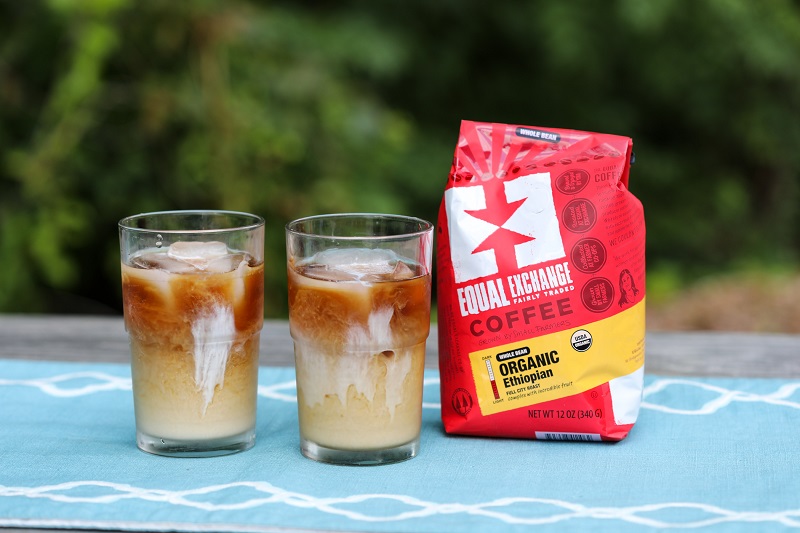
Cold brewed iced coffee may seem like just a trend, but we’re pretty sure this delicious method is here to stay. Instead of using heat to extract flavor from the beans, the cold brew process utilizes time. That means you’ll need to plan ahead a bit.
The good news is, you can make this iced coffee at home without any special equipment. Cold brew is ridiculously easy! Just take coarse-ground coffee, add cold or room-temperature water and stir. Then allow the mixture to steep for at least six hours, or overnight. Finally, strain with cheesecloth or a filter. Ta da!
The magic ratio is 1:4 – four cups water for every cup ground coffee. The finished cold brew concentrate will be double-strength, so make sure to add equal parts water before you sip.
Learn to make cold brew from a barista!
• Use good quality coffee! To us, that means organic coffee sourced from small-scale farmers who are paid fairly for their work.
• What specific kind of coffee makes the best iced coffee? Anything you like hot will probably taste good cold. (French Roast fan? Try an iced French Roast. Prefer decaf? Make iced decaf.) That said, our coffee experts enjoy the fruity notes of natural process African coffees like Equal Exchange’s Organic Ethiopian and our special Cold Brew blend.
Read more about natural process coffee.
• Always use fresh filtered water, and make sure the beans you’re using are freshly ground. Your iced coffee will taste better!
• Like it sweet? If you’re using a hot-brewing method, try adding sugar before the coffee is cool. It will dissolve more quickly. If you’re doing cold brew, try adding simple syrup.
• Did you know you can coffee in an ice cube tray to create ice cubes that won’t dilute iced coffee? Genius!
• Utilize the power of science to cool your iced coffee quicker. Use a large container like a pan to create more surface area before putting it in the fridge. Or try a metal vessel to cool your iced coffee – metal conducts heat most efficiently.
Thank you for signing up for our newsletter!
This month, we took The Stories Behind Our Food on the road. Danielle and Kate interviewed Igor Kharitonenkov of Bootstrap Compost at his home in Boston, where we checked out his garden and learned about all things compost!
Waste diverted from landfills: 4.5 million pounds
Compost created: 2.2 million pounds
Greenhouse gases offset: 3.2 million pounds
That’s the equivalent of 24,366 trees or 1,734 acres of forest land. Looking at the offset another way, it represents 1.6 million pounds of coal or 165,800 gallons of gasoline that were not burned!
You can hear #StoriesBehindOurFood on:
Stitcher (on both Apple and Android.)
Apple Podcasts (Apple devices only.)
Google Podcasts (Android devices only.)
or wherever you enjoy online audio!
Subscribe to The Stories Behind Our Food to hear the newest episodes, right when they release. And don’t forget to review!
Intro: (00:01)
everyday grocery store items like bananas, chocolate, coffee. These are global commodities. They pass through a lot of people’s hands on their way from the fields to your grocery cart. This is the stories behind our food podcast, the podcast where expert guests share insider knowledge about every step along the process. I’m Danielle Robidoux — and I’m Kate Chess — and we’re your hosts. All right.
Kate: (00:29)
Hello. The stories behind our food is on the road this week. Danielle and Gary, our producer are being hosted right now by Igor Kharitonenkov of Bootstrap Compost. He’s the Co founder and chief operating officer. Thanks so much for joining us today.
Igor: (00:45)
Thank you for having me.
Kate: (00:46)
Thanks for hosting us and giving us pomegranate juice. Pretty awesome. I want to start out by asking you about your mission. Basically, I think composting isn’t super mainstream in the US. Why do you think that is?
Igor: (01:02)
Well, it takes a lot of time and effort to compost. You have to be genuinely interested in it to actually create a good nutrient rich soil. A lot of people try to compost in their backyard and what they do is they basically are just creating a mini landfill, because they’re just throwing food scraps, one on top of the other. you need a, you know, mix the compost, you need to water it. Occasionally you need to make sure it has access to sunlight so that all those microbes and macro and micro decomposers can have an environment where they thrive.
Kate: (01:35)
Yeah. I think you’re getting into this already, but if you can explain basically from a scientific perspective how composting works and how it’s different from a landfill.
Igor: (01:44)
Sure. Well, first of all, composting is a much better use of resources then than landfills are. according to the EPA, 14% of waste is compostable, but only 2.9% of that is actually composted. So we’re on average every day producing enough food waste to fill a stadium the size of Gillette, where the Patriots play full of food waste and that’s mostly going to the landfill. composting is good for a variety of reasons. first of all, of course you’re creating a, a soil out of it that can be used. It’s a nutrient rich soil amendment that can be used to grow and help grow and help create a really, a really positive sort of ecosystem for plants to thrive in. I put compost on my garden, you know, I have really beautiful Kale growing back there and tomatoes and it really helps create the proper kind of environment with the right kind of nutrients that a plant is supposed to have. But the other reason composting is so good is because of the fact that it actually offsets, greenhouse gases. So in a landfill, you are creating methane gas, methane gas. It’s, you know, we always say landfills are where food scraps go to die and methane gas is the byproduct of that. Methane gas is 14 to 20 times more potent than carbon dioxide.
Kate: (03:17)
Where does it come from? It’s just being like, it’s coming out of the piles of an uncompensated scraps?
Igor: (03:25)
You know, I’m not a chemist, but I do know that food scraps and other stuff that’s just sitting there and rotting creates methane gas.
Kate: (03:33)
Gotcha.
Igor: (03:34)
But with composting, you’re flipping that, that food waste, you’re adding water, you’re adding naturally heat as added through that process. And I believe it’s a combustion reaction, but essentially you’re taking methane gas and you’re converting it to carbon dioxide, which again is 14 times less potent in the environments you’re actually offseting greenhouse gases by, by composting. Take this, for example, every pound of food waste that you can post, you’re actually offsetting around 0.9 pounds of, of greenhouse, of greenhouse gases. to put that into terms, every mile you drive, you pump out one pound of carbon dioxide. So essentially, you could offset your whole footprint. You know, by composting, say, you know, I mean you’d have to compost a lot of food and maybe change your lifestyle a little bit, but you could really have a zero waste kind of neutral greenhouse gas lifestyle with the help of composting. So…
Kate: (04:38)
That’s pretty compelling. I think a lot of people don’t see what they can do as individuals, but this, especially when you’re doing it on large scale as your businesses and we’ll get into that. It’s got, it gives me a lot of hope. That’s neat.
Igor: (04:51)
And I think going back to why don’t more people compost? Well it does take a lot of work. People are busy here in Boston. People don’t have the space to do it. oftentimes they don’t have the time to do it themselves. So services like ours, really help. I just read a statistic that said that of non– 72% of people don’t compost. But of those 72%, 67% say they would compost if it was, if there was a convenient way to do it. Now convenient is a relative term to some people, convenient might mean buying a tumbler and putting it in their backyard instead of having a pile. A tumbler is a device that you essentially spin and rotate. And over time, those food scraps, you know, you add your carbon sources, your, your nitrogen sources, your, your browns and your greens essentially for a healthy compost pile, you need both a lot of leaves and carbon sources, even cardboard or you know, paper materials like that. And then you also need your, your food scraps, your banana peels, your leftovers. So that might be, that’s easy for someone, for other people, that means actually having a service like Bootstrap. So recently I was in New York City for the community composting, conference. And there are businesses starting up all over the country. We were one of the original community composting operations in America. and we’re one of the biggest ones now. People really look up to us and we frequently, frequently get inquiries from places in Florida or Alabama or California, Oregon. Across the board. There are, you know, hundreds of companies starting now that are looking up to us and looking up and seeing that people are starting to become more conscious with their food waste. So many years ago we became sort of conscious about how we eat. More and more people are buying organic. More and more people are buying local. I think more people are into even gardening. and now that same kind of clientele that is shopping at Whole Foods and is really buying into kind of the values that what they stand for, what they put in their body. They also want to put back into the planet via composting. So we started serving Jamaica Plain. That was our initial neighborhood. We had a few dozen clients and now we’re, you know, out in the Back Bay with, you know, what I would consider a higher end clientele. You know, the people that can afford, you know, the lattes and you know, the Yoga studio classes and, and now they have a composting bin too. So that’s a really cool revolution that I’ve seen over the, over the time of this business is that we’re not just reaching kind of this niche audience of, you know, I don’t want to put a label on it, but people that are just really, into the environment. Now we have people that are into a lot of things, but they also are into the environment as well.
Kate: (07:52)
Yeah. Make compost. Cool. Make compost mainstream. Yeah, that’s right. Can you explain — I’m seeing the obstacles here. People want to do this, they already want to do this more and more, but they don’t necessarily know how to do it and they don’t have the space. So how do you make it convenient for city dwellers here in Boston?
Danielle: (08:07)
Yeah. Admittedly I was one of those people that you were talking about earlier who by accidentally was making a mini landfill in my back yard. So I’d love to hear what, how it works for an individual
Igor: (08:18)
About starting your own compost pile or about signing up with Bootstrap?
Danielle: (08:21)
Signing up with Bootstrap. Didn’t work for me. Right?
Igor: (08:26)
So if you are interested in composting, and again, if you don’t have the space or time to do it or maybe you’re not creating the kind of soil that you wanted to, you can sign up with us. And what we do is we deliver a five gallon bucket to your house. if you’re, if you’re a resident, we also provide commercial services as well. but if you’re a resident, you can sign up and we give you that bucket. You can fill it with …basically anything that grows goes. So we accept produce, we accept meat products, you know, and then we, and then we come by and based on your needs, we can come by once a week or once every two weeks and pick up that bucket, swap it out, give you a fresh, clean bucket. We sanitize, we clean and sanitize every single bucket. We put a nice little compostable liner around it, so it’s really smell free, it’s hassle free. And on the day of your pickup, you just place it outside on your front porch. We swap it out and you get to start again.
Kate: (09:32)
Do you have to do a lot of educating? Do people know what they can compost and what they can’t? Or has that been a problem for you?
Igor: (09:40)
\It hasn’t been a problem, but it’s sometimes a little bit of an issue with our commercial accounts. So we serve a lot of, a lot of offices for example. And that’s another movement where I’ve seen, you know, it used to be just Nature Conservancy or Series and now we have Puma and Uber and Lyft and just these big brand names that are now part of, you know, having composting services at their office. I visit them frequently. Toast Boston for example, is a huge growing company and they have so many compost bins and they fill them all up. it’s, it’s pretty amazing to see and it’s a huge impact because at an office you are potentially reaching thousands of people and educating them about composting. But sometimes things can go wrong because not everybody understands what to put in the compost Bin and what not to put. Or maybe they’re in a hurry and they’re just kind of like, you know, throwing it wherever and the first empty bin. With our residential subscribers, it’s not a problem. Again, it’s a volunteer kind of service. You don’t have to sign up for it. You can if you want.
Kate: (10:49)
They’re highly motivated already. They already want to do it. So they probably know more.
Igor: (10:53)
Exactly. Yeah. So they already know how to do it. Plus we send them, you know, like a little leaflet little flyer that says what you can and can’t compost. We, there’s plenty of Info online about, so, so people are, you know, if they’re, if they’re buying into it, they’re usually gonna follow the rules. Yeah. That being said, we have had, you know, a bucket full of diapers delivered to us once. Staying on the theme of poop, we once had a lady that was throwing her dog poop in the compost bin. So we’ve had a few weird incidents along the way, but 99% of those buckets are really just good food waste.
Danielle: (11:32)
Yeah. So what is your personal area of expertise? I know you talked kind of being that bleeding heart environmentalist. What, what is your background and what gave you this idea and wanting to get into this?
Igor: (11:51)
That’s something I think about a lot. my background is actually in psychology and I moved to Boston to pursue a phd in neuropharmacology, which lasted all of eight months. I did not decided I did not want to, pursue on that career path and kind of be stuck in a lab and the academic environment just didn’t suit me. I think by nature I’ve always been a bit of a risk taker and a businessman, you know, I was that kid, you know, going around the neighborhood, mowing lawns for people, making a little money, shoveling snow, you know, any opportunity I could make a dollar, you know, like I tried. then after Grad school I kind of floated around. I did some media work for a little bit, I did some communications work, but my heart was always in, in the environment and how do we help the environment. So I, initially saw a flyer for Bootstrap Compost and I thought, hm, that’s a cool service. I want to, I want to be a part of that. And I profiled Andy in a video.
Kate: (13:03)
This is your cofounder, right?
Igor: (13:05)
Andy is, yeah, my co founder, and I, this was back when he had like, you know, 40, 50, 60 clients in Jamaica Plain. And after that video, he really liked the work that I did. I think the video had got a lot of views. so I did some more stuff for him for free and then he decided to, you know, take me on for a few hours a week just doing part time marketing. He needed help. He was doing all aspects of the business. and somewhere along the way I just kind of developed a business acumen for efficiency, for operations, for hiring, all these things that it takes to grow and scale a business. We now have 26 people working on our staff. we serve over 3000 clients. and all that took a bit of risk taking and a lot of management. And I guess over the years I’ve just realized that those are some skills that I have.
Kate: (14:03)
Bootstrap describes itself on its website as a social enterprise. What does that mean to you?
Igor: (14:09)
It means a lot of things. I have a whole hour talk about social enterprise and what it means to be a social enterprise. I’ve done talks at UMass and Tufts to a variety of students. I’m talking about social entrepreneurship. what it means to me is you’ve heard of the bottom, the triple bottom line. I mean, probably it’s the good for people, good for planet, good for profits. So I think that’s kind of like the basis of it. you know, for example, in house we invest in our workforce, so we give people above livable wages, we have health insurance, we’re now starting to unroll 401k plans. and we give bonuses and we always pay people and we put them on flexible schedules. We have several people who work remotely with us and they’re getting their job done and it’s treating each other with respect and treating each other with kindness, in house. So that’s what we do in house. outside of that we are big in the community. So we do a lot of education. We have a community outreach team that, is spearheaded by one of our employees who, together. Her and I designed a very robust K-6 sort of curriculum about composting a an hour long presentation essentially to that we can shop around and go to schools with and teach kids about, you know, the importance of composting, talking about soil health, talking about plant health, talking about some of these issues like the landfill stuff I was bringing about bringing, talking about, and methane and all that other stuff. And it really ties in a lot of like science, technology, math kind of stuff. We bring the worm bin too occasionally. The young kids really love the worms. They love to look into, you know, that compost bin. And we asked them to like find a, a warm egg or find a big worm finally. So we do a lot of that with kids. the service in itself is a social enterprise, I feel like because as I mentioned that offices, you’re reaching a lot of people and teaching them about, behaviors that are more favorable for the earth. the buckets out on the curb out on this front step make people wonder, Oh, what does bootstrap compost? They look it up to like, oh, composting made easy. Hmm. What’s that?
Kate: (16:41)
Yeah. If you look at their Instagram, you can see a lot of the buckets, but we’re talking about a branded bucket that has the name of the service on it. So people who see it will know right away. This isn’t just a random bucket. There’s a purpose for it.
Igor: (16:53)
Yeah, exactly. we hire, we hire folks with disabilities and they come into our warehouse through Triangle and they work with us four days a week. that’s something I’m extremely proud of that partnership and we’ve been able to keep it going now for I think coming up on three years. and it gives folks with disabilities a sense of purpose and meaning and an income, for a population that has historically been disenfranchised or misunderstood. And we love those guys. They come in and they just, they just, they just crush it. and then we have a community outreach team, which, goes back to the compost donations. We give out a lot of compost to community gardens. We just gave one a to a community garden that’s starting up in Chinatown. We delivered 20 buckets to another community garden. I can’t think of the name right now. but there’s a lot of compost that’s being given out. We have a budget. you know, we try to do 1% or more of our revenue goes back into causes we believe in. So not only do we donate compost, but we also do financial donations. So we’ve donated to the ACLU, the Hyde Square task force, among many other organizations that we believe in, that uphold the spirit of, you know, liberty and, and and, and doing something right.
Kate: (18:26)
It’s awfully efficient that you can advertise your own service and simultaneously be teaching people about good behaviors that are good for the earth. Even if they’re not, they don’t choose to go with Bootstrap, like, you can without feeling like it’s just an ad. You can talk about what you do and get new supporters. But also have people like really learn something useful that’s, that’s good for the world.
Igor: (18:48)
Yeah. It’s a win win. And we don’t try to be salesy. People come to us. We’ve grown tremendously this past year, especially in the commercial sector. And there’s just a little signup form or a little information form that people fill out and we get five inquiries a day, 10 inquiries a day of commercial clients who want to sign up with our service. So we’re just clearly getting out.
Kate: (19:09)
Can you talk about, we haven’t actually gotten to this yet. What happens to the food you pickup? What happens to the compost you make?
Igor: (19:15)
Yeah, so we work primarily with one farm where it gets turned into compost. They have, an in-vessel, system where they take the food waste and they put it into this giant sort of screener that is also, powered by I believe, diesel. and it runs for like a, I don’t know what the capacity is, but it’s massive. It’s the size of like a semi semi truck, like an 18 wheeler. and food waste gets put into that and they spin it around and they heat it. And within 24 hours, you have 90% finished compost. Actually 24 hours. Yeah. And the screener, the screen is actually able to separate, it’ll keep the like bad stuff in and the compost, it gets screened out. Then they take that compost and they put it into these large mountain sized piles. They’re not actually the size of mountains, but they’re pretty big. They’re probably the size of this house. so, and then that, that sits there and they come by with a tractor and turn it, you know, every, every couple of days. And, and we’ve tested their compost and it tests really, really well. in terms of testing low for heavy metals testing high for nutrients, we always test the compost before we, do our, you know, giveaways. so that’s one thing that happens. We work with another farm, which is much more agrarian if you want to put it that way. They just have a basic three, three, like it’s not a three bin system, but it’s like three areas.
Kate: (20:54)
Piles.
Igor: (20:55)
Yeah. Three piles essentially. Yeah. And so they have one pile that’s like the act of pile where we would dump food scraps that gets turned in. The middle pile is when you’re no longer dumping, but it’s not fully finished than the last pilot’s to fully finished compost. So they have that kind of system would go there once a week. So they get maybe about, you know, a thousand pounds a week less than that.
Kate: (21:15)
And these farms are using the finished compost — other than what you donate, like you mentioned earlier that the compost — they’re using it for their food production?
Igor: (21:24)
So the first farm, they’re a commercial composting site. They sell the compost or they give compost back to us. And with our partnership they give us as much compost as we want, as, as much as we need to be able to do our donations to be able to, give back to our residents and even to do some sales. we mixed their compost actually with some of our own worm castings, which are, you know, the most potent kind of compost. So even just a little teaspoon of worm castings is enough for one plant. whereas with compost you’d want like a handful of compost for one plant. So we mix it in and we kind of branded as our own Bootstrap compost that we sell or give away or donate. But the other farm, they actually do use their compost on their crops.
Kate: (22:11)
Yeah. Cool. I’m seeing a lot of packaging, like food packaging recently that’s marketed as compostable anyway. Is that something that you can handle and do you have thoughts on that movement toward packaging food in compostable … I don’t know what it is. Bioplastic or something?
Igor: (22:27)
We can handle a limited amount. we’re fortunate enough that most of that stuff we, we don’t get a lot of that stuff. So most of our, I’d say 95 to 98% is food scraps. So we don’t have a lot of, compostable packaging that comes our way. My personal viewpoints on it are mixed. While it’s probably better than plastic. I still think it’s kind of contributes to a culture of a throw away culture, and a culture of waste. And, I’m not sure what even like what the ratios are for the amount of resources that you need to create, a compostable cup versus a plastic cup versus, so I probably need to do a little more research on that. But I do think generally speaking that it would be better if offices used, you know, people used water bottles or or plates like real plates and real forks and knives. But then again, I understand, I’ve been to some of these offices that have, you know, thousand employees running around with literally a cup of coffee in one hand, a laptop and the other. So convenience is a factor and it’s just something we’re dealing with. And I guess it’s better to have compostable plastics then than to not have them. But on the flip side, too many of those and farms can’t process them. And, and they have to go to digesters. And, and I know for a fact that that digester in Charlestown doesn’t accept, you can put them in, but it’ll grind them up and it won’t go into the slurry. It’ll just be thrown away with the stuff that’s, you know, that’s the byproduct. So it’s really hard to compost that stuff.
Kate: (24:19)
Ironic. But good to know.
Danielle: (24:23)
Yeah, it is ironic.
Kate: (24:24)
Yeah.
Danielle: (24:26)
I think another thing to think about, especially for a lot of our listeners is the individual behavior that we have and how that impacts what companies do. We have a lot of those compostable packaging now because it’s been demanded. You want the convenience, but you want, you know, the quote unquote environmentally friendly that turns out it’s not so environmentally friendly. And I think what I want to stress to our listeners and to individuals is to really own your individual behavior and how that impacts what companies do and that it’s important to buy whole foods. It’s important to buy bulk and your food and your grocery store. And when you buy packaged goods and you continue to buy packaged goods, that’s going to change the behavior of where you’re buying that. So, I don’t know if you have any thoughts on kind of how folks’ individual behavior kind of impacts maybe the way you do business and you know, the other folks you’re doing business with as well.
Igor: (25:25)
Well, it’s interesting you bring that up because 40% of our food is wasted across the board, whether it’s a restaurant, whether it’s a household. And that’s really sad because if food waste was a country, I believe it would be the second largest producer of energy and like the third largest use user of energy and the third largest user of water.
Danielle: (25:53)
Wow.
Igor: (25:54)
And that’s globally speaking, that’s not just the US but in the US it’s 40%. And you’re right. I mean it’s, it’s, it’s like, you know, don’t go to Costco and buy six heads of lettuce because it’s gonna cost you $3 less, you’re going to end up wasting three of those heads of lettuce. Yeah. If you’re buying it for your family, you know, I go to Costco, I’ve completely stopped buying the produce there because I realized that it’s just half of it just goes bad. And I’m, I’m part of the problem when that happens. So, you know, with produce, just be very careful and mindful of what you buy and how much you buy. sSo that does come down to individual decisions, individual behaviors, eat your leftovers, you know, if you’re at a restaurant, take it home, eat it for lunch the next day. Try to be creative about your cooking. Try to not order out so much and you know, eat, eat, eat healthy and eat well. Try to do some gardening if you’ve, you know, got the interest and start to really appreciate food more than what it takes to grow it because it’s not easy. And as far as the industry goes, I think we’re coming up with more sophisticated ways of food packaging. There’s a company out in California called Apeel and they’re coming up with an organic sort of, by organic, I mean plant based, plant based coating that you can put on produce, which increases the shelf life from say, you know, a banana that would go bad in three days to like seven or eight days. And it’s that those are little technologies that are going to go a long way in the future, that are going to help us reduce food waste because it’s not just that, it’s also grocery stores. It’s also, you know, in the transportation of the food. It’s also at the farms. So I’m talking about big, big systemic issues that we have with food waste. And we at Bootstrap always say like, we sometimes open up a bucket and we see like a perfectly fine potato in there. We always wonder like, why didn’t you just eat that? Like, or it might have like a little smudge on it that you could just cut off. So like people have this idea that they’re, and as much as I love Whole Foods, I think Whole Foods has contributed, the company, to like this idea of like shiny, happy food. Yeah. their produce is very high quality, but it’s also like, you don’t need the perfect apple all the time. Yeah. You don’t need to have the perfect tomato. okay.
Kate: (28:31)
Food can be ugly and still be good and tasty and nutritious. It’s interesting to hear somebody who’s in the compost biz say that actually it’s better to not have too much food than it is to compost the extra. Reducing the amount of food that you buy and eating what you, what you buy rather than buying too much and putting it in the compost. It’s not actually a zero emission solution. Anything that you want to cover that we haven’t touched on?
Igor: (28:57)
Yeah, I mean, one thing that I talked about, was, well, one thing that we didn’t really cover was the impact that Bootstrap’s had. And that’s something that I, you know, I’m really proud of. So since 2011, we’ve kept four and a half million pounds of food waste out of landfills. We’ve created 2.2 million pounds of compost through the process of composting. We’ve offset 3 million, 3.2 million pounds of greenhouse gases, which, that number is not just fictitious. You can go online. EPA has a calculator. you can go in and plug your numbers, how much you drive and you know, how much our vehicles are on the road versus how much we collect. That’s the number we have 3.2 and that 3.2 million of greenhouse gases offset is the equivalence of planting 24,366 trees. Or creating 1,734 acres of forest land. To put that in perspective, that’s slightly larger than if you were to combine the Back Bay, the South End and the Fenway neighborhood and turn it all into a forest. We’ve kept 1.6 million pounds of coal from being burned. Again, that’s an equivalency. or if you look at gasoline, we’ve, we’ve prevented 165,800 gallons of gasoline from being burned and that is the equivalent of taking close to 1700 trips from Boston to LA and a car hundred trip and a 30 mile per gallon car.
Kate: (30:38)
Wow. Yeah. I’m going to, for people who don’t process numbers when they hear them, I’m going to put these numbers on our blog as well so you can look at them. I think that’s really impressive and really speaks to the good work Bootstrap’s doing. Thank you so much for joining us, Igor. I’ve definitely learned a lot and I know our listeners will as well. And if you are in the Boston area, I hope you’ll, you’ll give Bootstrap a thought for your composting needs.
Igor: (31:01)
Thank you for your time. I loved having you guys here.
Danielle: (31:05)
Thank you.
Outro: (31:08)
Thanks for listening to The Stories Behind Our Food, a podcast by Equal Exchange, inc a worker-owned cooperative. Love this episode? Please subscribe, rate and leave a review. Be sure to visit equalexchange.coop to join the conversation, purchase products and learn more about small scale farmers and the global supply chain. This episode was produced by Equal Exchange with hosts, Kate chess and Danielle Robidoux and sound engineering provided by Gary Goodman. Join us next time for another edition of the Stories Behind Our Food.

